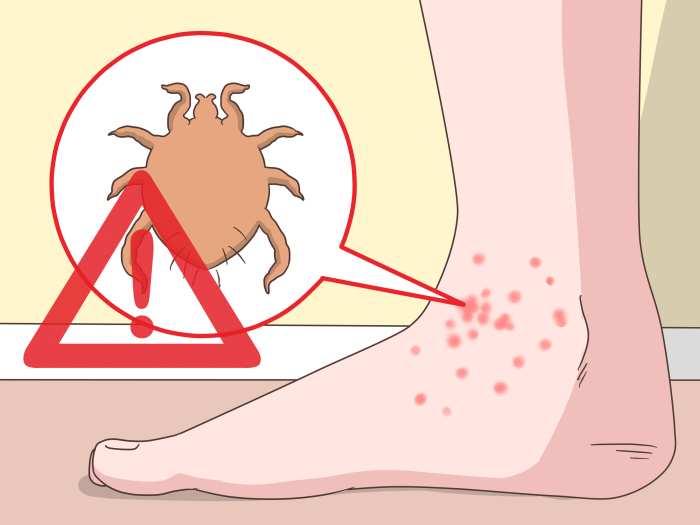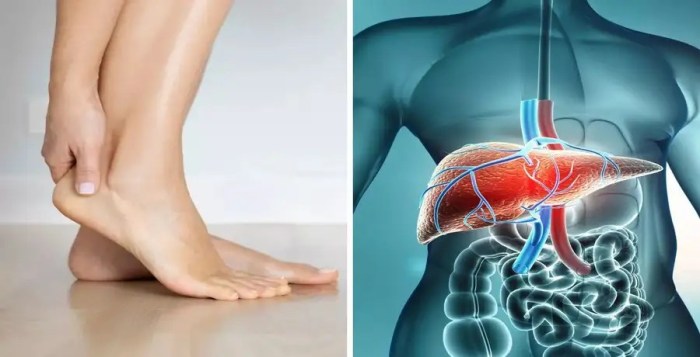Four skin conditions that make your feet itch can be incredibly frustrating. Understanding the underlying causes and symptoms is key to finding relief. This guide explores athlete’s foot, eczema, psoriasis, and other fungal infections, providing detailed information about each condition, including symptoms, causes, treatments, and preventative measures. We’ll also discuss home remedies and when to seek professional help.
From the common to the less familiar, we’ll unpack the various factors contributing to itchy feet. We’ll look at not only the skin conditions themselves but also other potential causes like allergies or insect bites. Prepare to delve into the world of foot health and discover the solutions that can bring you relief.
Introduction to Foot Itch
Itchy feet are a common complaint, often disrupting daily life and causing discomfort. While sometimes a minor annoyance, persistent foot itching can signal an underlying skin condition requiring medical attention. Understanding the potential causes and associated symptoms is crucial for proper diagnosis and treatment. This section delves into the various reasons behind itchy feet, emphasizing the importance of identifying the root cause to achieve effective relief.Identifying the specific skin condition causing the itch is vital for targeted treatment.
A misdiagnosis can lead to ineffective therapies and prolonged discomfort. Symptoms vary depending on the underlying condition, providing valuable clues for proper medical evaluation. A comprehensive understanding of the symptoms associated with different skin conditions affecting the feet can aid in self-assessment and facilitate early diagnosis.
Common Causes of Itchy Feet
Various factors can contribute to itchy feet, ranging from simple irritants to more serious medical conditions. These include: contact dermatitis from irritants like harsh soaps or footwear materials; fungal infections, such as athlete’s foot; allergic reactions to certain substances; and skin conditions like eczema or psoriasis. Proper identification of the cause is essential to implement the appropriate treatment strategy.
Symptoms of Foot Itch
The symptoms associated with itchy feet vary depending on the underlying cause. Some common symptoms include: persistent itching, redness, dryness, flaking, cracking, blisters, and in some cases, burning or stinging sensations. Careful observation of these symptoms can assist in pinpointing the potential cause of the itching.
Skin Conditions Causing Itchy Feet
It is important to note that several skin conditions can lead to itchy feet. A proper diagnosis requires a comprehensive evaluation by a healthcare professional.
| Skin Condition | Symptoms | Causes | Treatment |
|---|---|---|---|
| Athlete’s Foot (Tinea pedis) | Itching, burning, redness, scaling, blisters, cracking skin between toes. | Fungal infection, often in damp or enclosed shoes. | Antifungal creams or oral medications prescribed by a doctor. Maintaining good foot hygiene and avoiding sharing footwear are crucial preventative measures. |
| Eczema (Atopic Dermatitis) | Dry, itchy, red, inflamed skin; possible small bumps or blisters. | Genetic predisposition, environmental triggers (allergens, irritants). | Moisturizing creams, topical corticosteroids (as prescribed), avoidance of triggers. |
| Psoriasis | Red, scaly patches on the skin, often with silvery-white scales; itching is common. | Autoimmune disorder, genetic predisposition. | Topical medications, phototherapy, and sometimes oral medications. |
| Contact Dermatitis | Itching, redness, rash, blisters, or burning at the site of contact with an irritant. | Reaction to specific substances (chemicals, cosmetics, plants). | Identifying and avoiding the irritant; topical corticosteroids, antihistamines, and wet compresses. |
Athlete’s Foot
Athlete’s foot, a common fungal infection, affects the skin of the feet. It’s characterized by itching, redness, and often, cracking or peeling skin. Understanding the cause, symptoms, transmission, and prevention is key to managing this often-annoying condition.
Fungal Infection
Athlete’s foot is caused by a group of fungi, primarily dermatophytes. These fungi thrive in warm, moist environments, making areas like locker rooms, public showers, and poorly ventilated shoes ideal breeding grounds. The fungi penetrate the skin’s surface, leading to inflammation and the characteristic symptoms of the infection. Fungal spores are ubiquitous, meaning they are present almost everywhere, but the fungi only grow and cause infection under specific conditions.
Symptoms
The symptoms of athlete’s foot often appear gradually. Common symptoms include itching, redness, and scaling between the toes, particularly the spaces between the fourth and fifth toes. The skin may become cracked, inflamed, and sometimes blister. In severe cases, the infection can spread to the soles of the feet. The intensity of the symptoms can vary greatly, ranging from mild discomfort to severe pain.
Transmission
Athlete’s foot is highly contagious. Transmission occurs through direct contact with infected skin, contaminated surfaces, or shared personal items. Common sources of transmission include: using public pools or locker rooms, walking barefoot on surfaces in public places, and sharing towels or shoes with someone infected. Maintaining good hygiene practices is essential to prevent its spread.
Comparison with Other Foot Conditions
| Symptom | Athlete’s Foot | Other Conditions (e.g., Psoriasis, Eczema) |
|---|---|---|
| Itching | Often intense, particularly between toes | Variable intensity, can be present in other areas |
| Redness | Localized, often between toes, may spread | Can be widespread, or localized, may be associated with inflammation |
| Scaling/Peeling | Dry, flaky skin, often white or yellow | Can present with scaling or shedding, but appearance may differ |
| Cracking/Blisters | Can occur in severe cases, especially in thick skin areas | Can develop cracking or blisters, depending on the condition |
| Odor | May be present in advanced stages | Typically not associated with strong odor |
Note: This table provides a general comparison. A healthcare professional should diagnose the specific condition.
Prevention
Prevention is crucial for avoiding athlete’s foot. Here are some key strategies:
- Maintaining good foot hygiene. Regularly wash and dry your feet, paying close attention to the spaces between your toes. Use a clean towel each time.
- Wearing appropriate footwear. Choose breathable shoes that allow air circulation to prevent moisture buildup. Change socks daily.
- Avoiding walking barefoot in public areas. Always use flip-flops or other protective footwear in public showers or locker rooms.
- Keeping your feet dry. Use a foot powder or antifungal spray to absorb moisture.
- Using clean towels and personal items. Do not share towels, shoes, or other personal items that may come in contact with your feet.
These simple preventative measures can significantly reduce the risk of contracting athlete’s foot.
Eczema (Dermatitis) of the Feet
Foot eczema, a common skin condition, presents as inflamed, itchy patches on the feet. It’s characterized by dry, cracked skin, often accompanied by blisters or weeping sores. Understanding the various types, triggers, and treatments can significantly improve management and alleviate discomfort.
Types of Foot Eczema
Foot eczema isn’t a single entity; rather, it encompasses several types, each with its own characteristics. Atopic dermatitis, a chronic condition, frequently affects the feet, manifesting as dry, itchy, and inflamed skin. Contact dermatitis, triggered by specific allergens or irritants, can also cause foot eczema. Lastly, dyshidrotic eczema, marked by tiny blisters on the soles of the feet and between toes, is another form that requires specific management.
Triggers and Risk Factors
Several factors contribute to the development of foot eczema. Common triggers include exposure to harsh soaps, detergents, or chemicals. Allergic reactions to certain materials, such as wool or latex, can also cause the condition. Individuals with a family history of eczema, asthma, or hay fever are at increased risk. Sweating, particularly in enclosed footwear, can exacerbate the condition.
Wearing tight or ill-fitting shoes can also contribute to friction and irritation, leading to eczema.
Symptoms of Foot Eczema
Symptoms of foot eczema vary depending on the type and severity. Common signs include redness, itching, and dryness. The skin may appear cracked or rough, with blisters or small sores forming. In severe cases, the skin may become thickened or scaly. The affected areas often feel intensely itchy, making scratching and further irritation a significant concern.
The symptoms can fluctuate in intensity, depending on factors such as the time of year, stress levels, and environmental conditions.
Treatments for Foot Eczema
Effective management of foot eczema involves a multifaceted approach. Moisturizing the affected areas regularly with a fragrance-free cream or ointment is crucial. Avoiding triggers is essential to prevent flare-ups. Prescription medications, such as topical corticosteroids, may be necessary in severe cases. In some situations, oral antihistamines can help alleviate itching.
Maintaining good foot hygiene, including using gentle soaps and thoroughly drying the feet after bathing, can also aid in managing the condition. If symptoms persist or worsen, consulting a dermatologist is recommended.
Differences Between Types of Foot Eczema
| Type of Eczema | Symptoms | Treatment |
|---|---|---|
| Atopic Dermatitis | Dry, itchy, inflamed skin; can involve weeping or scaling. Often associated with other allergic conditions. | Moisturizing, avoidance of triggers, topical corticosteroids (as prescribed). |
| Contact Dermatitis | Inflammation and itching at the site of contact with an allergen or irritant; often localized. | Identifying and avoiding the trigger; topical corticosteroids (as prescribed); antihistamines. |
| Dyshidrotic Eczema | Small blisters, often on the soles of the feet and between toes; intensely itchy. | Moisturizing; avoiding triggers; topical corticosteroids (as prescribed); in severe cases, oral medications. |
Psoriasis: Four Skin Conditions That Make Your Feet Itch
Psoriasis is a chronic autoimmune skin condition that causes skin cells to multiply rapidly. This rapid cell turnover leads to the formation of thick, scaly patches on the skin. While it can manifest anywhere on the body, including the feet, it often presents unique characteristics when affecting this area.
Characteristics of Foot Psoriasis
Psoriasis on the feet often displays inflamed, red patches that can be covered with silvery-white scales. These patches can vary in size and shape, and may be accompanied by cracking and fissures in the skin. The affected skin may also be itchy and painful, particularly when the scales are thick or inflamed. The presence of these characteristics can help differentiate foot psoriasis from other skin conditions.
Ever wondered why your feet are constantly itching? Four common skin conditions can be culprits, like athlete’s foot, eczema, psoriasis, and fungal infections. While dealing with these foot issues, have you considered the amazing benefits of aloe vera? It’s a natural remedy that can help soothe skin irritations and even treat acne and acne scars, just like aloe vera for acne and acne scars demonstrates.
Knowing how to use aloe vera topically can be a great way to ease the itchiness associated with these skin conditions on your feet.
Potential Triggers for Foot Psoriasis
Several factors can trigger or worsen psoriasis on the feet. These include infections, injuries, stress, and certain medications. Exposure to extreme temperatures or harsh chemicals can also play a role in exacerbating the condition. For example, a fungal infection could lead to psoriasis flare-ups. Similarly, trauma from ill-fitting shoes or repeated friction can initiate a flare-up.
Also, periods of significant stress or emotional distress may also trigger or worsen psoriasis.
Symptoms and Visual Presentation of Foot Psoriasis
The symptoms of foot psoriasis can vary depending on the severity of the condition. Common symptoms include red, inflamed skin patches, often with a silvery-white buildup of scales. These patches can range from small and localized to large and widespread, affecting the entire foot. In some cases, the scales may be so thick that they form cracks or fissures in the skin, leading to pain and bleeding.
The affected skin may also be itchy, dry, and sore. Visual presentation can range from mild to severe, with the severity depending on the individual and the specific triggers.
Treatment Options for Foot Psoriasis
Treatment for foot psoriasis aims to reduce inflammation, control scaling, and alleviate symptoms. Several approaches are available, including topical corticosteroids, vitamin D analogs, and coal tar preparations. These treatments can help manage the symptoms and slow the progression of the condition. Systemic medications, such as methotrexate or cyclosporine, may be necessary in severe cases. Phototherapy, using ultraviolet light, can also be effective in reducing inflammation and scaling.
Comparison Table: Foot Psoriasis vs. Other Itchy Foot Conditions
| Feature | Psoriasis | Athlete’s Foot | Eczema |
|---|---|---|---|
| Appearance | Red, inflamed patches with silvery-white scales, often with cracking and fissures. | Red, itchy rash between toes, often with scaling and/or blisters. | Red, itchy, and inflamed skin; may have weeping or oozing; can vary in appearance depending on the type. |
| Cause | Autoimmune response | Fungal infection | Allergic reaction or irritation |
| Symptoms | Inflammation, scaling, itching, pain, cracking, fissures. | Itching, burning, scaling, blisters, peeling. | Itching, dryness, redness, inflammation, sometimes oozing or crusting. |
| Treatment | Topical creams, phototherapy, systemic medications | Antifungal creams or oral medications | Moisturizers, topical corticosteroids, anti-inflammatory medications |
Fungal Infections (Beyond Athlete’s Foot)

Itchy feet aren’t always limited to the common culprit, athlete’s foot. A variety of fungal infections can affect the skin on your feet, each with unique characteristics and treatment approaches. Understanding these variations is crucial for proper diagnosis and effective management.Beyond the typical symptoms of athlete’s foot, other fungal infections present with distinct features, impacting different parts of the foot and requiring tailored treatments.
This discussion will explore various types of fungal infections, detailing their symptoms, causes, and treatment options to provide a comprehensive understanding.
Types of Fungal Foot Infections
Various fungal species can affect the feet, leading to different symptoms and requiring tailored treatment approaches. Recognizing these distinctions is key to effective management.
- Tinea manuum (Hand Tinea): This fungal infection, similar to athlete’s foot, affects the skin on the hands. It often presents with itchy, red, scaly patches, sometimes with blisters. It’s typically spread through contact with contaminated surfaces or objects. Treatment involves topical antifungal creams or oral medications, depending on the severity.
- Tinea cruris (Jock Itch): This fungal infection primarily affects the groin area, inner thighs, and buttocks. It’s characterized by itchy, reddish-brown, and often ring-shaped rash. Warm, humid environments and close-fitting clothing can contribute to its development. Topical antifungal creams are usually effective in treating this type of fungal infection.
- Tinea pedis (Athlete’s Foot): While already discussed, a brief overview is included. This common fungal infection affects the skin between the toes and soles of the feet. It’s characterized by itching, burning, scaling, and cracking of the skin. Warm, humid environments and tight-fitting shoes can increase the risk. Topical antifungals are usually the first line of treatment.
- Fungal Nail Infections (Onychomycosis): These infections affect the toenails or fingernails. They typically manifest as thickened, discolored, brittle, or crumbling nails. Fungal infections can spread from the skin to the nails. Treatment often involves oral antifungal medications or topical treatments, depending on the severity and location of the infection. In some cases, surgical removal of the infected nail might be necessary.
Comparing Fungal Foot Infections
Understanding the distinctions between different types of fungal infections is vital for effective treatment.
| Fungal Infection | Symptoms | Causes | Treatment |
|---|---|---|---|
| Tinea manuum | Itchy, red, scaly patches, sometimes with blisters on the hands | Contact with contaminated surfaces or objects, sharing towels, or poorly ventilated environments. | Topical antifungal creams or oral medications (severe cases). |
| Tinea cruris | Itchy, reddish-brown, ring-shaped rash in the groin, inner thighs, and buttocks. | Warm, humid environments, close-fitting clothing, and sharing of personal items. | Topical antifungal creams. |
| Tinea pedis (Athlete’s Foot) | Itching, burning, scaling, and cracking of the skin between toes and soles of the feet. | Warm, humid environments, tight-fitting shoes, and sharing of personal items. | Topical antifungal creams. |
| Fungal Nail Infections (Onychomycosis) | Thickened, discolored, brittle, or crumbling nails. | Fungal infection spreading from the skin to the nails, sharing of personal items, or weakened immune systems. | Oral antifungal medications or topical treatments, possibly surgical nail removal. |
Other Potential Causes of Itchy Feet
Itchy feet aren’t always a sign of a skin condition. A range of underlying factors, from allergies to nerve issues, can contribute to this discomfort. Understanding these possibilities is crucial for accurate diagnosis and effective treatment. Proper identification of the root cause is essential for appropriate management and alleviating the frustrating itch.Beyond the skin, several other factors can trigger foot itching.
These can include allergic reactions, insect bites, or even underlying medical conditions. Pinpointing the precise cause often requires a thorough evaluation, considering both the symptoms and medical history.
Allergic Reactions
Allergic reactions to certain substances, such as detergents, certain fabrics, or even certain foods, can manifest as itchy feet. Symptoms often include localized redness, swelling, and a burning sensation alongside the itch. Direct contact with the allergen is not always necessary; some individuals might experience a reaction after consuming the allergen. Food allergies, for example, can sometimes manifest in unexpected ways, including itchy skin.
The reaction’s severity can vary depending on the individual and the allergen’s potency. A detailed medical history and careful observation of potential triggers are important in identifying the specific allergen.
Insect Bites and Stings
Insect bites or stings can cause localized itching, redness, and swelling around the affected area. The intensity of the reaction can vary significantly. Some individuals might experience only a mild irritation, while others may develop a more pronounced allergic response. Identifying the specific insect responsible for the bite or sting can be challenging, but understanding the type of insect present and its usual biting pattern can help with diagnosis.
A thorough examination of the bite site, along with consideration of the individual’s medical history, is critical in this diagnosis.
Nerve Issues
Certain nerve conditions, such as neuropathy, can cause itching, often accompanied by tingling or numbness in the feet. These sensations are often described as unusual, making them stand out from typical skin-related itches. The itching may not be the primary symptom; it can be associated with pain, weakness, or other neurological problems. A neurological examination and potential nerve conduction studies are essential diagnostic tools.
Ever wondered why your feet are itching? It could be anything from athlete’s foot to eczema, psoriasis, or even a fungal infection. Dealing with these skin conditions can be frustrating, but imagine the challenges of caring for a loved one with ALS; caring for a loved one with ALS requires immense patience and understanding, just like learning to manage these annoying foot conditions.
Ultimately, recognizing and treating these issues is key to alleviating discomfort and maintaining healthy feet.
Symptoms can vary depending on the specific nerve condition.
Other Medical Conditions
Some underlying medical conditions can sometimes lead to itchy feet. For instance, kidney or liver diseases, diabetes, or even thyroid disorders can contribute to this discomfort. These conditions may exhibit symptoms beyond just itching. It’s essential to remember that itching can be a non-specific symptom, and it is crucial to consider a wider range of possibilities when assessing the issue.
A thorough medical evaluation, including blood tests and other diagnostic procedures, is often required to rule out underlying medical conditions.
Differentiating Itchy Feet Causes
| Potential Cause | Symptoms | Differentiation from Skin Conditions |
|---|---|---|
| Allergic Reactions | Localized redness, swelling, burning, itchiness; possible connection to specific triggers (e.g., detergents, fabrics). | Allergic reactions often involve a wider area of inflammation and may have a distinct pattern, unlike skin conditions that typically involve discrete lesions. |
| Insect Bites/Stings | Localized itching, redness, swelling, sometimes a visible puncture mark. | Insect bites are typically localized, while skin conditions can spread. Look for the presence of a bite mark or a pattern of bites. |
| Nerve Issues | Itching accompanied by tingling, numbness, pain, weakness; possible history of neurological disorders. | Nerve-related itching is often associated with other neurological symptoms, unlike skin conditions which are usually isolated to the skin. |
| Other Medical Conditions | Itching accompanied by other symptoms related to the underlying condition (e.g., kidney problems, fatigue). | Underlying medical conditions typically present with a broader range of symptoms beyond just itching. A thorough medical evaluation is essential to assess the condition’s impact on the body. |
Home Remedies and Self-Care
Managing itchy feet often involves a multifaceted approach combining home remedies, proper hygiene, and a healthy lifestyle. Addressing the underlying cause is crucial, but many individuals find relief through simple, at-home strategies. These methods can provide temporary relief while working towards a long-term solution with a doctor.Many causes of itchy feet respond well to self-care measures. These steps can help manage symptoms and prevent future issues.
Understanding the root cause and adopting appropriate home remedies is essential for effective management.
Ever wondered why your feet are itching? Four common skin conditions can cause this irritating sensation. Dry skin, athlete’s foot, eczema, and psoriasis can all lead to itchy feet. While dealing with these issues, it’s important to remember that seasonal changes can affect our mood too. For instance, winter blues can impact your well-being, and finding ways to combat seasonal affective disorder (SAD) is key.
Check out these 4 ways to tackle seasonal affective disorder to help you feel better: 4 ways to tackle seasonal affective disorder. Fortunately, understanding the triggers for these skin conditions can help you manage them better, leading to happier, healthier feet.
Foot Hygiene Practices
Maintaining proper foot hygiene is fundamental in preventing and managing itchy feet. Regular washing with mild soap and lukewarm water is crucial. Avoid harsh soaps or excessive scrubbing, which can irritate the skin. Thorough drying, especially between toes, is essential to prevent moisture buildup, a breeding ground for fungal infections. Properly fitting footwear that allows for airflow and ventilation is also vital to keep feet dry and comfortable.
Balanced Diet and Hydration
A balanced diet rich in vitamins and minerals, particularly vitamin C and zinc, contributes to overall skin health, including the health of your feet. Sufficient hydration keeps the skin supple and prevents dryness, which can exacerbate itching. Drinking plenty of water helps maintain the body’s overall fluid balance, which is beneficial for healthy skin function.
Preventative Measures for Healthy Feet
Implementing preventative measures for healthy feet is key to avoiding the discomfort of itchy feet. Wearing clean, breathable socks, especially during activities that lead to sweating, can prevent fungal infections. Regular foot checks for any signs of irritation, redness, or unusual growth are important. Using moisturizing creams or lotions regularly can help maintain healthy skin hydration. Proper footwear selection, avoiding tight or constricting shoes, and using foot powder can contribute to overall foot health.
Home Remedy Comparison Chart
| Condition | Home Remedy | Effectiveness |
|---|---|---|
| Athlete’s Foot | Applying antifungal creams or powders | Generally effective, especially when used consistently and as directed. |
| Eczema (Dermatitis) of the Feet | Applying hydrocortisone cream or other topical corticosteroids (use only as directed by a doctor) | May provide temporary relief, but the underlying cause needs addressing. |
| Psoriasis | Applying moisturizing creams, emollients, or topical treatments as prescribed | Can help soothe the affected skin and reduce inflammation, but long-term management is essential. |
| Fungal Infections (Beyond Athlete’s Foot) | Using antifungal foot soak solutions | May provide relief from itching and dryness, but needs to be combined with other measures. |
| Other Potential Causes | Applying cool compresses to reduce inflammation and itching | Can offer temporary relief from itching and swelling. |
When to Seek Professional Help
Dealing with itchy feet can be frustrating, and sometimes, it’s a sign that something more serious is going on. Knowing when to seek professional help is crucial for getting the right diagnosis and treatment, preventing complications, and ensuring your comfort. Don’t hesitate to reach out to a healthcare provider if you experience persistent or worsening symptoms.Seeking medical attention for itchy feet is essential because self-treating can delay proper diagnosis and potentially worsen the condition.
A healthcare professional can identify the underlying cause, differentiate between various conditions, and prescribe the most effective treatment plan tailored to your specific needs.
Signs Warranting Immediate Medical Attention
Persistent itching, especially if accompanied by other symptoms, requires prompt medical evaluation. The following situations demand immediate attention:
- Sudden onset of intense itching, particularly if accompanied by swelling, redness, blistering, or open sores on the feet.
- Itching that spreads rapidly across the foot or to other parts of the body.
- Itching that’s associated with a fever, chills, or other systemic symptoms.
- Signs of infection, such as pus, oozing, or a foul odor emanating from the affected area.
- Presence of skin discoloration, thickening, or scaling beyond the typical appearance of common skin conditions.
- Numbness or tingling in the affected area, alongside the itching.
- Itching that significantly interferes with daily activities or sleep due to discomfort.
Reasons to Consult a Doctor, Four skin conditions that make your feet itch
Prompt medical intervention is vital for several reasons. A doctor can accurately diagnose the cause of your itchy feet, which is crucial for effective treatment. Furthermore, they can identify potential underlying health conditions. Early intervention is essential for preventing complications and maintaining overall well-being.
- To rule out more serious conditions like skin infections or allergic reactions that require immediate medical intervention.
- To determine the precise cause of the itching, distinguishing between various skin conditions such as fungal infections, eczema, or psoriasis.
- To receive personalized treatment recommendations tailored to your specific needs, avoiding potential adverse effects from incorrect self-treatment.
- To monitor the progression of the condition and adjust treatment strategies as needed, preventing potential complications.
- To prevent the spread of infections to other parts of the body or to other individuals.
- To ensure that the itching doesn’t mask a more serious underlying medical condition.
Important Considerations
Accurate diagnosis is paramount when dealing with itchy feet. A healthcare provider can distinguish between various conditions and develop a suitable treatment strategy. They can rule out underlying health issues and provide necessary care.
- Delayed diagnosis and treatment of skin conditions can lead to more severe complications.
- The presence of systemic symptoms, like fever, should always prompt immediate medical attention.
- The severity of itching can vary considerably depending on the underlying cause, ranging from mild discomfort to intense pain.
Final Review

So, what’s the takeaway? Itchy feet can stem from a variety of skin conditions and other factors. Understanding the specific symptoms, causes, and treatments for each condition is crucial for effective management. This guide provides a comprehensive overview to help you navigate this frustrating issue. Remember, proper foot hygiene, a balanced diet, and staying hydrated are essential for maintaining healthy feet.
Don’t hesitate to consult a doctor if you’re unsure about the cause or if symptoms worsen. You’ve got this!




